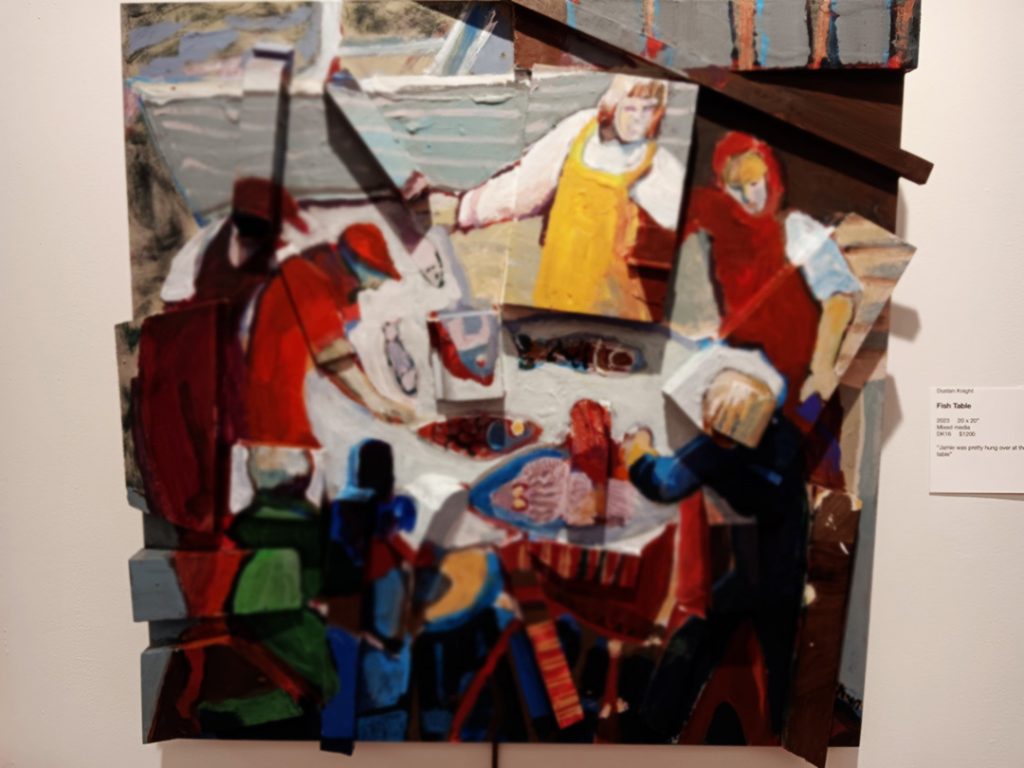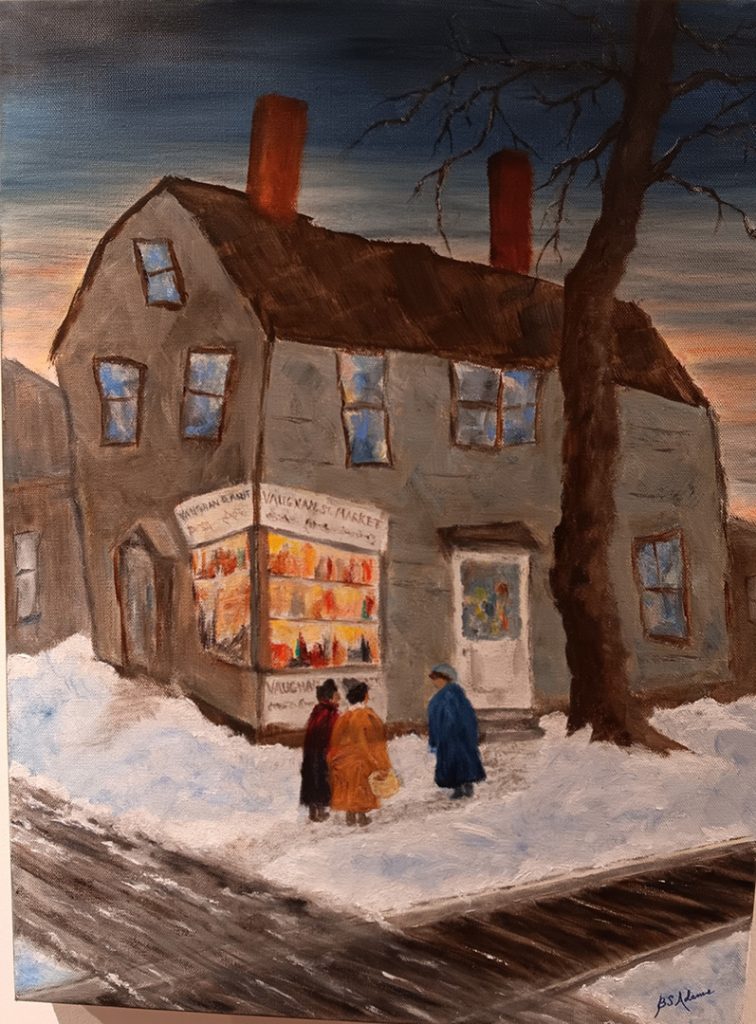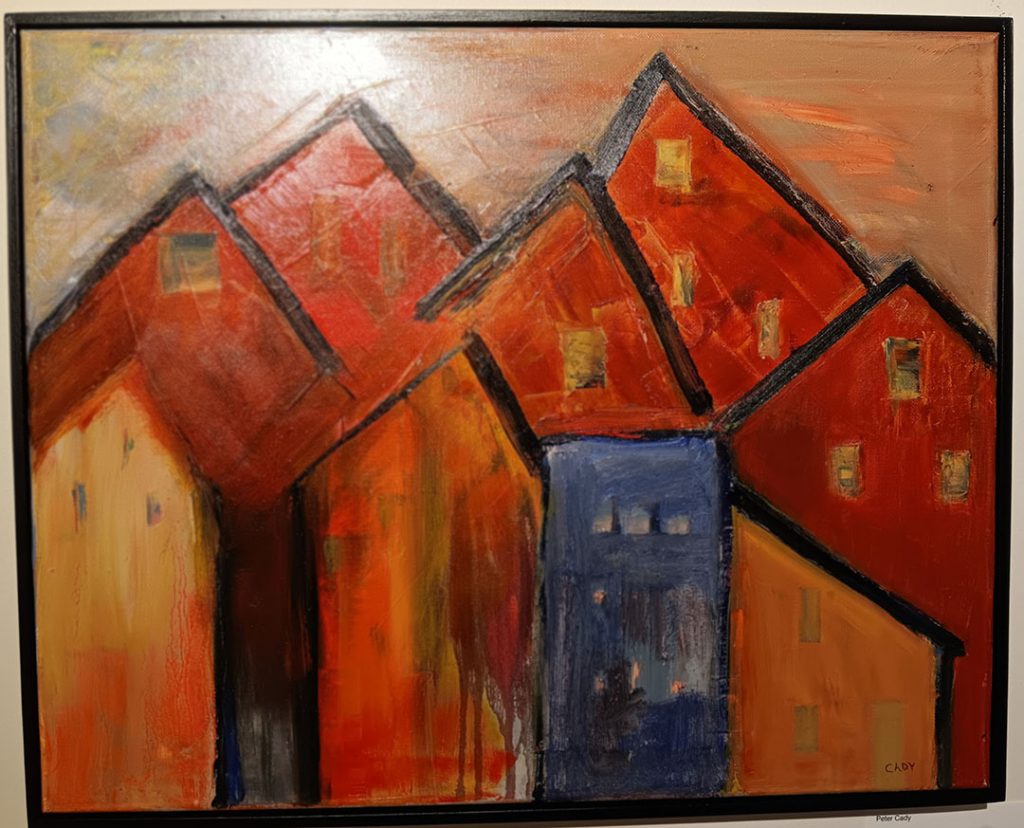A very different city once stood here. The working-class town that was Old Portsmouth might be gone, but the “Lost Neighborhoods” exhibit at the Portsmouth Historical Society, organized by Portsmouth 400, offers us a chance to glimpse the past through artists’ eyes.
Four artists – Tom Glover, Dustan Knight, Peter Cady, and Barbara Adams – rediscovered Old Portsmouth by exploring the photo archives of the Athenaeum and by speaking with longtime residents. Their paintings “speak to their sense of loss and admiration for the close-knit communities that made Portsmouth what it was,” according to a statement displayed with the exhibit.
The statement describes a shared nostalgia among the artists “for an earlier, vibrant, rougher seacoast lifestyle.”
Earlier, vibrant, and rougher – these words describe the paintings and their subjects as well as Old Portsmouth. The colorful (and even three-dimensional) artwork portrays historic homes and old neighborhoods, along with the colorful characters who occupied them.
Themes of Old Portsmouth
Common themes in the paintings include multi-generational homes, neighborhoods lost to time and urban renewal, and work.
Barbara Adams’s painting, “Front yard laundry,” (not shown) includes at least two things we don’t see in Portsmouth anymore: a dilapidated, old home and laundry hanging up in the front yard.
It was probably a common scene at one time. I can’t remember the last time I saw laundry hanging up outdoors, but my mother still hung ours outside when I was young.
We find a different waterfront in Portsmouth, too. Dustan Knight’s “Fish Table” depicts a visceral scene at a visceral job. A group of people stand around a table, presumably processing fish from a recent catch. One wears a yellow apron.

A caption on a card next to the painting reads, “Jamie was pretty hung over at the fish table.” Some paintings have quotes next to them. No explanation is offered, although in the case of “Fish Table,” none is required.
Evoking old communities and neighborhoods
“Vaughan Street Market,” by Barbara Adams, was my favorite painting in this show. It wasn’t because it depicted Old Portsmouth so well, so much as it evoked a lot of old communities.
In front of a gray colonial building, three ladies stop to chat under a darkening winter sky. The crooked windows tell us this isn’t one of Portsmouth’s fine old mansions.

It was probably clad in chunky asbestos shingles, and the thin glass windows must have rattled in the wind. The three ladies might have been neighbors. They would have helped each other through blizzards and brought food when one was sick.
I never saw Old Portsmouth, but as a child, I saw parts of my grandparents’ neighborhood in Medford, MA, that hadn’t seemed to change much. Charming, humble bungalows had small yards that spilled over into each other, and people knew their neighbors.
My grandmother talked about how quick people were to help each other. I have often thought that community must have been easier and more natural back then, before television and electronic devices, before the decay of the family as the social unit and the neighborhood as a place to belong.
It must have been a sad day, indeed, when the bulldozers came to dismantle Portsmouth’s Old North End. Several pieces in the exhibit focus on the destruction wrought by urban renewal, although this is not the theme of the show.
Peter Cady’s “Elevation” has a warm feel to it, with its reddish-brown buildings in the background, and blue and yellow homes in the front. It gives us a sense of a community built close together and sticking together.

The sky is gray, a rusty stain runs down the central house, and there are no trees or plants, but the huddled houses still create a sense of place.
Few people in Portsmouth today would trade places with the immigrants who came to labor in button factories, or the fishermen who eked out a meager living from the sea. But they had a sense of community that they created together – out of necessity, perhaps, but isn’t that the strongest kind?
In viewing this exhibit, I wondered what a future “Lost Neighborhoods” show might look like. In 40 years, will people wonder what Portsmouth looked like, before a Ford dealership replaced the McIntyre building, or another bank replaced the North Church? Will the symbol of future Portsmouth be a sterile, brick-and-steel hotel building, instead of a white steeple? I wonder.
The “Lost Neighborhoods” show is exhibited at Portsmouth Historical Society, 10 Middle Street, until December 30.










